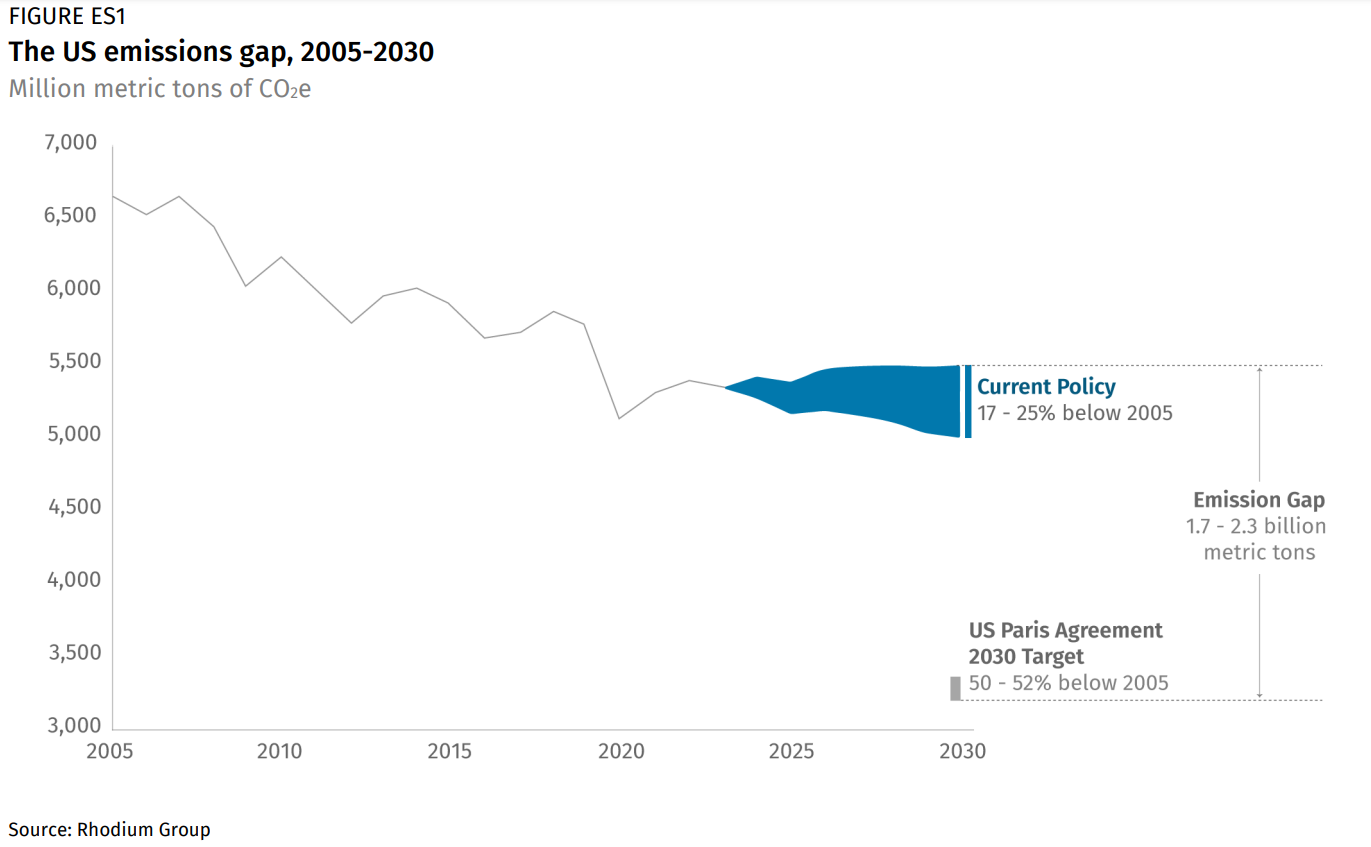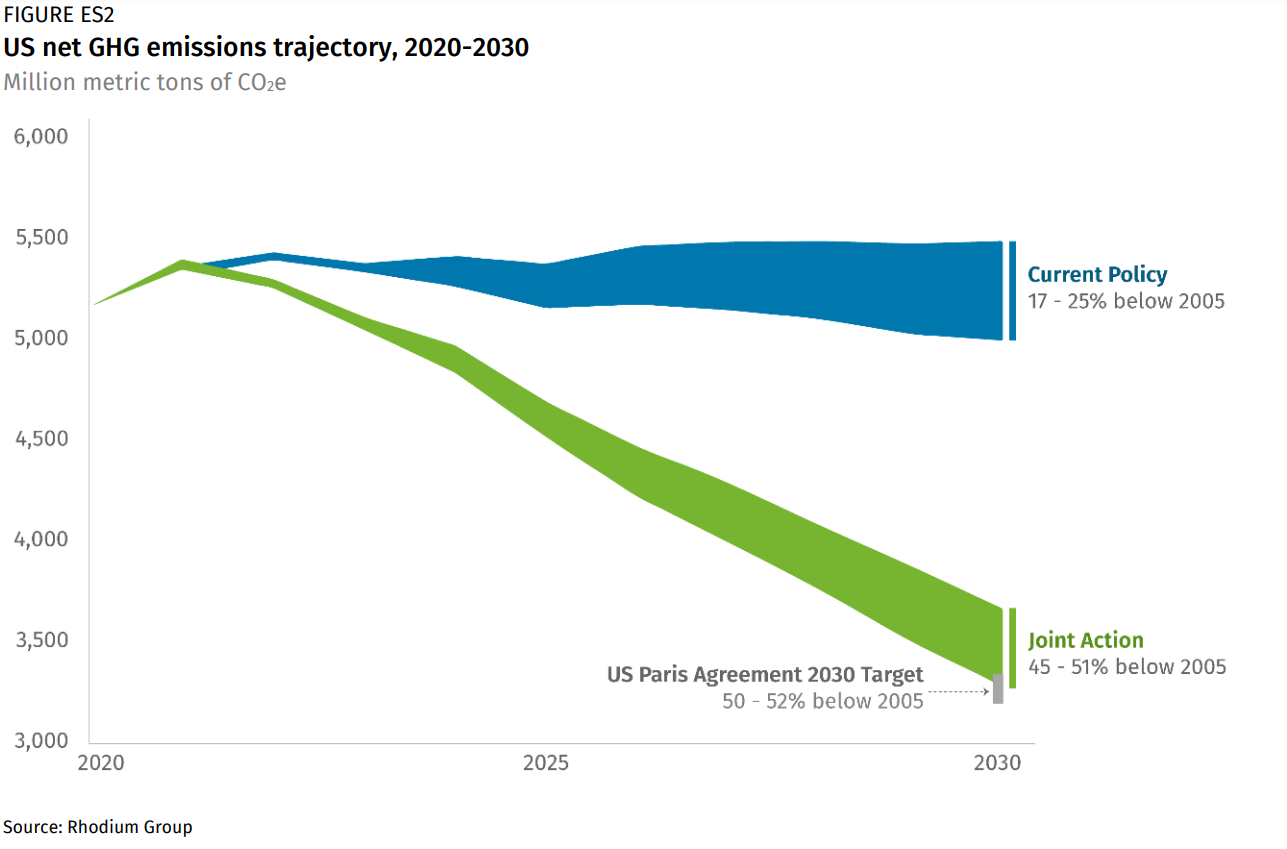Pathways to Paris: A Policy Assessment of the 2030 US Climate Target
Meeting the US's 2030 climate goal is achievable if Congress, the executive branch, and subnational leaders all take a series of feasible policy actions.
Over the course of this year, the impacts of climate change have become more immediate and tangible. A cascade of natural disasters—floods, hurricanes, wildfires, droughts, and extreme heat —have touched nearly every corner of the US. Meanwhile, it’s clearer than ever that the planet is on track for even more intense impacts in the decades ahead if action isn’t taken soon to avoid the worst climate damages.
President Biden campaigned on a platform that prioritized action on climate change. Now in office, the Biden administration has taken a whole-of-government approach to the issue, placing staff in key agencies to coordinate federal efforts to cut emissions. As part of this effort, President Biden submitted a nationally determined contribution (NDC) under the Paris Agreement, pledging the US will cut net greenhouse gas (GHG) emissions in the range of 50-52% below 2005 levels by 2030.
Meanwhile, congressional leaders are shepherding a major infrastructure package and a multi-trillion dollar spending bill towards the finish line. The two bills combined have the potential to be the largest action ever taken to abate climate change in US history. In a few weeks, world leaders will meet in Glasgow, Scotland for the UN Climate Change Conference (COP26) to enhance global action and limit warming to 1.5 degrees Celsius. As other countries step to the plate with bold ambition, they will need to be able to trust that the US can deliver on its 2030 promise of a 50-52% reduction.
This report aims to provide an independent, objective, and policy-focused assessment of the US 2030 target. We combine our knowledge of the US economy, energy systems, and policy design with state-of-the-art modeling tools to comprehensively answer two questions: Can the US cut net GHG emissions by 50-52% by 2030 and if so, what does a policy pathway to the target look like?
We consider actions by all key actors in the US federal system, including legislation under construction in Congress, regulations and other actions that can be taken by the Biden administration and key departments, as well as actions by climate-leading states and corporations. The suite of policies we consider is not intended to be exhaustive. Instead, it represents a series of actions that can be reasonably expected to occur over the next nine years if leaders in all levels of government work in earnest to address climate change. Based on this analysis, here is a summary of our key findings.
Without new action, the US will not meet its 2030 target
Under current policy as of May 2021, with no new action, the US is on track to reduce GHG emissions 17-25% below 2005 levels in 2030. The range reflects uncertainty around energy markets, clean technology costs and the ability of natural systems to remove carbon from the atmosphere. This leaves a gap of 1.7-2.3 billion metric tons of emission reductions required to achieve the US target in 2030 (Figure ES1). The gap is roughly equal to all 2020 emissions from the transportation sector on the low end and all emissions from electric power and agriculture combined on the high end.
While the challenge of closing the gap is daunting, achieving the target is in line with what’s required to avoid the worst impacts of climate change. Not following through on this commitment risks undermining the credibility of the US and reduces the chances of an ambitious multilateral response to climate change.
Joint action by Congress, the executive branch, and subnational leaders can put the 2030 target within reach, but all must act
Our analysis demonstrates that meeting the US’s 2030 target is achievable, if Congress, the executive branch, and subnational leaders all take a series of practical and feasible policy actions—what we refer to as our “joint action” scenario (Figure ES2). This scenario represents passage this year of the infrastructure bill and budget reconciliation package in Congress, coupled with a steady stream of standards and regulations by federal agencies and accelerated action by leading states and companies. Combined, these actions can cut US net GHG emissions to 45-51% below 2005 levels in 2030.
At each level of government, we identify practical policy actions under clearly established authorities (where applicable) that, if pursued on reasonable timelines, can help achieve the target. No one level of government alone can deliver on the target. None of the policies we identify are novel or new, and all federal regulatory action can be implemented with existing legal authority. To close the emissions gap, agencies and states will need to pursue new actions at a pace, scope, and level of ambition that has not been seen to date, but which are also practical and within reach.
Action across all sectors of the economy is required to achieve the 2030 target
We find that the biggest opportunities for emission reductions in this decade reside in the electric power sector—covering 39-41% of total reductions achieved in the joint action scenario. If actions to cut electric power sector emissions are not successful, then achieving the 2030 target may not be possible. Even so, achieving the target will require successful emission reduction actions across all sectors of the US economy, not just the power sector, as well as increased natural and technological removal of carbon from the atmosphere.
Achieving the 2030 target can also cut harmful air pollutants and consumer bills
Getting US emissions on track to reach the 2030 target can be done with little cost to consumers. Long-term tax credits, investments in energy efficiency and other factors cushion consumers from price increases associated with new standards and regulations. On a national average basis, households save roughly $500 a year in energy costs in 2030 in our joint action scenario. Many policy actions that cut emissions also reduce harmful air pollutants. For example, SO2 emissions in the electric power sector decline to near zero by 2030.
If Congress fails to act, the 2030 target may be in jeopardy
Congressional action is critical to achieving the 2030 target for two reasons. First, measures in the infrastructure and budget packages can enable and accelerate clean technology deployment and on their own cut emissions significantly. Second, those same programs reduce consumer and compliance costs of federal and state actions that, combined with congressional actions, put the target within reach. Without the cost reduction assistance of congressional actions, federal and state leaders will face higher technical and political hurdles as they pursue the ambitious policies required to get to the 50-52% target. Congressional investments in emerging clean technologies will also drive innovation to enable the next wave of decarbonization after the 2030 target is reached.
Achieving the target will be a historic feat but is only halfway to the net-zero finish line
If all actors successfully pursue all aspects of the joint action scenario and achieve the 2030 target, it will represent one of the most monumental national achievements in recent decades. Even then, achieving the ambitious goal puts the nation just halfway to the longer-term goal of net-zero emissions by mid-century, which is the level required for the US to play its role in a robust global response to the threat of climate change. Getting to net-zero will require new policies and the commercial scale-up of a suite of emerging technologies like clean hydrogen, direct air capture, and advanced zero-emission electric generation, as well as continued electrification of transportation and buildings. Without near-term progress on these fronts in the years ahead, closing the gap to net-zero emissions by 2050 will be even more challenging than getting to the 2030 target.
RELATED RESEARCH:
For more information about our approach and methods, read the Pathways to Paris Technical Appendix.
For a June 2022 progress update, read Progress on the Pathway to Paris?
For the implications of the Supreme Court’s ruling in West Virginia v. EPA, read Has the Supreme Court Blocked the Path to the 2030 Climate Target?

